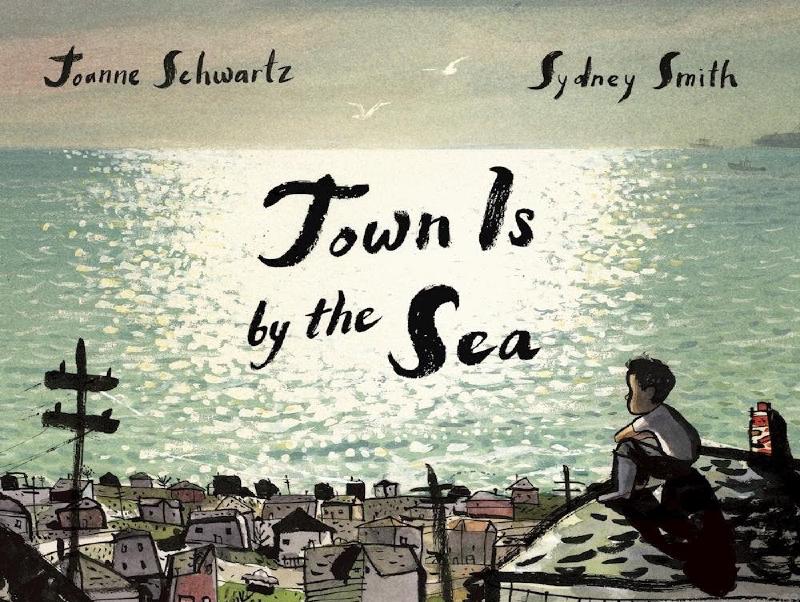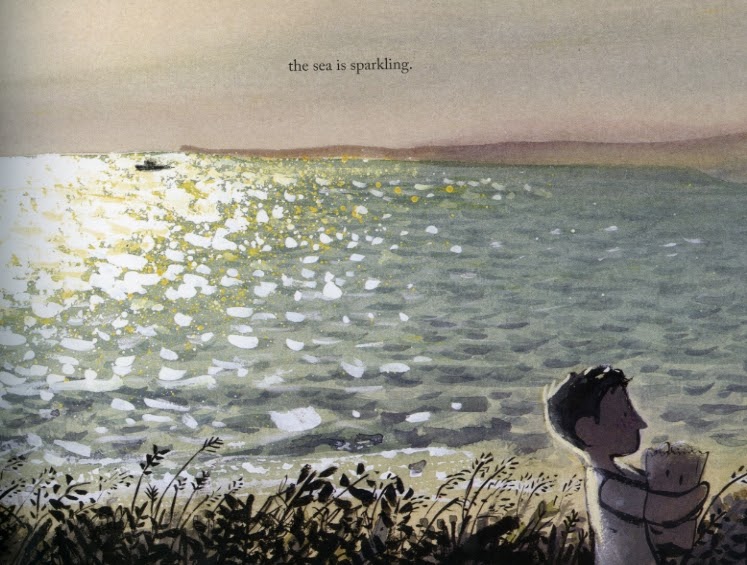Curriculum links
- History
- Personal, social, health and economic education ( PSHE )
Publisher’s summary
A young boy wakes up to the sound of the sea, visits his grandfather’s grave after lunch and comes home to a simple family dinner, but all the while his mind strays to his father digging for coal deep down under the sea. Stunning illustrations by Sydney Smith, the award-winning illustrator of Sidewalk Flowers , show the striking contrast between a sparkling seaside day and the darkness underground where the miners dig.
With curriculum connections to communities and the history of mining, this beautifully understated and haunting story brings a piece of history to life. The ever-present ocean and inevitable pattern of life in a maritime mining town will enthrall children and move adult readers.
In Environmental Education
Transitioning away from fossil fuels is necessary. This book can be used as an entrypoint to thinking about the impacts this transition will have on communities which depend on mining. In this story we can imagine the impact on the shops in town if people no longer had work from the mines. There is also the impact on the boy’s future. At the end of the book he knows what he will do when he grows up. He will work down in the tunnels because “that’s how it goes”. Living in a community where jobs tend to be passed down, it’s not clear that the boy feels this is a limitation. How might he feel if that future prospect was removed and not replaced?
I think about the bright days of summer and the dark tunnels underground. One day, it will be my turn. I am a miner’s son. In my town, that’s the way it goes.
-Town is by the Sea
Throughout the story the sea is a bight and calm presence which lends the story a nostalgic, hazy, summer day quality. Yet the narrative and illustrations put tension between the bright surface waves and the father digging under the sea in dark tunnels. Thinking about this tension leads the reader to thinking about that parts of life in this town which we aren’t told about. The presence of the mine brings many economic positives to the community, but many negatives as well. Not the least of which is the worry for the miners underground.
In the book we are told about a sunny summer day. The sea in the book is calm but in reality it can also be powerful and violent. This other side of the sea will become more pronounced as oceans warm and storms become more intense. As readers we are left to imagine what life in this community would be like if we do not transition away from fossil fuels. The boy would grow up and take his turn in the tunnels, like his father and grandfather, but how will a day in his son’s life go?
Discussion ideas
Feelings - This is a beautiful book for exploring more subtle emotions. There are few facial expressions as clues, and, instead the reader needs to rely on body language, and the connection between the words and the illustrations. Discuss how the boy might be feeling at different moments in the book. When he looks at the sea, plays on the swings, waits for his father to come home.
Some things change. Some things stay the same. - Kids can reflect on day- to-day routines which don’t change. They might also think about times a routine changed. How do they feel about their routine? How did they feel when a routine changed? Kids could reflect on patterns in their life they wish they could change and think of how they might be able to make that change happen.
Following in footsteps - In one estimate (Financial Times, Feb 25, 2016), during Victorian times around 50% of children ended up in the same job as their mother or father, today it is less than 10%. In the story children following in their parent’s footsteps is the way things go. How does this make kids feel? Do they want to follow in their parent’s footsteps? What steps do kids need to do in order to achieve their goal?
Activity ideas
History: Visit a mine or factory
As the industrial revolution recedes farther into the past, there are many communities where former mines and manufacturing facilities have reopened as heritage sites. Often these places are important to the area’s transition into a different economy. These sites are also often staffed by local people with strong connections to that industrial heritage. Simply visitng and speaking with the staff and volunteers is wonderful way to honor that heritage and support their community.
Art: Paint the sea
The sea is a recurring theme throughout the book, and
the paintings of it are beautifuly calming. Watch videos of ocean waves as a
calming transition from other activities and to observe the shapes and
patterns waves make. Create a seascape using one of more painting techniques.
- Watercolour tutorial // How to Paint Waves - Youtube
- Paint beautiful gouache waves - Youtube (techniques work with poster/tempera paint)
- Acrylic Painting Tutorial - How To Paint Waves - Youtube (techniques work with poster/tempera paint)
Art: Emotions in figures
Look at how the illustrator uses subtle cues to tell the redear how the characters are feeling. Try drawing simple stick figures in different poses that show different emotions. How does changing the position of the head change how it feels? Adding a line for a mouth, how do changes in the shape of the line change how it feels?
Geography: Where do materials come from?
Kids research materials which come from the ground and how they are extracted. What everyday objects use materials which come from mining? What are the environmental consequences of different type of mining? Taking this project further, kids could consider what life would be like humans reduced or stopped mining.
History: What happens when a mine closes?
There are many communities around the world which formed because of, and continue to depend upon, mining. Kids could research what has happened to mining towns when the mines closed, and think about how people’s lives might have changed. What are the consequences for smaller bussinesses if a big part of the community loses their jobs? What might affect how easy or difficult it might be for people to get other jobs? How could communities be supported to make the transition easier?
- How Ex-Miners Turn Toxic Land into Lavender Farms - Business Insider via YouTube
- Coal communities in transition: A case study of Colstrip, Montana - Resources for the Future; Envirionmental defense fund
More about the book
Book review - Just imagine
Language arts unit on Town is by the Sea - Teachwire.net
More activities and discussion ideas - Cast of Thousands
Further exploration of themes in the book
Career aspirations
The jobs you’re most likely to inherit from your mother and father - The New York Times
Supporting students’ career and educational aspirations - Teacher Magazine
A framework for student goal setting - Edutopia
Transitioning away from mining
Appalachia is transitioning from coal. Here’s what it could learn from Germany. - Heinrich Boell Foundation
This Kentucky coal town is fighting for survival long after the war on coal is over - CNBC


